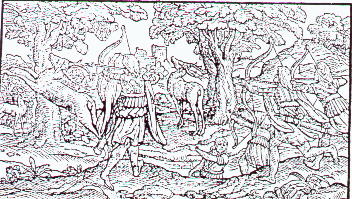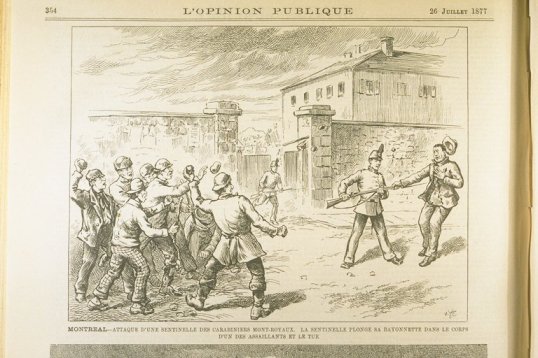Bareknuckle Technique from a drawing at Kilmainham gaol, Dublin (Ireland) – Year 1818
Bareknuckle Technique from a drawing at Kilmainham gaol, Dublin (Ireland) – Year 1818
Contributed by Thorsten Schindler.
“The Foot Pad and the Cane” 1905
One of the most interesting things to surface over the last few years.
Wake poem and artwork 1825
Found by Maxime Chouinard
Drinking, dancing, fighting and carrying on at an Irish wake! Looks to have the rare image of a woman holding a shillelagh…and smoking a pipe.
Political Cartoon Faction Fight 1846
Found by Maxime Chouinard
John Doyle 1846
Listed Personalities (left to right)
Herbert of Lea, Sidney Herbert, Baron, 1810-1861 #5914
Graham, James, Sir 1792-1861 #5740
Aberdeen, George Hamilton Gordon Earl of 1784-1860 #4221
Wellington, Arthur Wellesley Duke of 1769-1852 #696
Peel, Robert Sir 1788-1850 #589
Sheil, Richard Lalor 1791-1851 #5823
O’Connell, Daniel 1775-1847 #574
Russell, John Russell, Earl, 1792-1878 #5597
Palmerston, Henry John Temple 3rd Viscount 1784-1865 #5598
Grey, Charles Grey, Earl, 1764-1845 #5606
Bentinck, George, Lord 1802-1848 #5732
Disraeli, Benjamin Earl of Beaconsfield 1804-1881 #204
Embedded text
I’m for the fellow with the whiskers. – I’ll break a head or two before it’s all over. – Die game, Bob. – We must give in. There’s no standing against such odds
Giraldus Cambrensis
From Louie again:
Giraldus Cambrensis who was in Ireland in the late 12 century
speaking of the weapons of the Irish, he says, ” they use pikes,
javelins, and great battleaxes, exceedingly well tempered;” and,
that ” they wield the axe with one arm, their thumb extending along
the shafts, and guiding the stroke, from whose violence neither
helmet, nor coat of iron mail, arc sufficient protection; whence it
has happened in our days, that a single stroke has severed a heavy-
armed horseman in two, thorough his massy covering of iron armour,
one side falling one way, and the other a contrary way.”
How powerful must the arm be, and how well tempered the weapon., to
achieve what is here related by an eye-witness and an enemy! ” These
hatchets’ he says, ” they always carry in their hand, as walking-
staffs, ready instruments of death, not requiring to be unsheathed
like a sword, or bent like a bow ; without further preparation than
raising the arm, it inflicts a deadly wound.”
An impartial history of Ireland, from the period of the English
invasion to the present time: By Dennis Taaffe 1811

A View of the State of Ireland as it was in the Reign of Queen Elizabeth: By Edmund Spenser
More from Louie:
“Also their short Bows, and little Quivers, with short bearded Arrows,
are very Scythian, as you may read in the same Olaus. And the same
sort both of Bows, Quivers, and Arrows, are at this day to be seen
commonly amongst the Northern Irish-Scots, whose Scottish Bows are ‘
not past three quarters of a Yard long, with a String of wreathed Hemp
slackly bent, and whose Arrows are not much above half an Ell long,
tipped with steel Heads, made like common broad Arrow Heads, but much
more sharp and slender ; that they enter into a Man or Horse most
cruelly notwithstanding that they are shot forth weakly”.
A View of the State of Ireland as it was in the Reign of Queen
Elizabeth: By Edmund Spenser

The Irish “Glibbes” Hairstyle
Also from Louie Pastore
The Irish “Glibbes” Hairstyle – The original helmet hair?
The Irish style of having long hair over the eyes and short hair at
the back which can be seen in Durer’s pic of Irish Kern/Scot
galloglas may have been considered as a form of head protection by
the Irish… was it practical, was it similiar to native American
ghost shirt that were supposed to guard against bullets or was the
comment by Spencer merely mocking the Irish?

“their going to battle without Armour on their Bodies or Heads, but
trusting to the Thickness of their Glibbs, the which (they say) will
Sometimes bear off a good stroke”
Spenser’s View of Ireland (1596)
Spenser also writes about his dislike of the mantle because the
Irish are hiding weapons and armour underneath them, he also
comments on the glibb hairstyle – outlaws can cut it off so that
they look nothing like themselves or pull it low over their eyes!
Worst of all some English are adopting it….
“But what Blame lay you to the Glibb ? take heed (I pray you) that
you be not too busie therewith, for fear of your own Blame ; feeing
our Englishmen take it up in such a general Fashiuon to wear their
Hair so immeasurably long, that some of them exceed the longest
Irish Glibbs.
Iren. I fear not the Blame of any undeserved Dislikes: but for the
Irish Glibbs, they are as fit Marks as a Mantle is for a Thief. For
whensoever he – hath run himself into that Peril of Law, that he
will not be known, he either cutteth off his Glibb quite, by which
he becometh nothing like himself; or pulleth it so low down over his
Eyes, that it is very hard to discern his thievish Countenance, and
therefore fit to be trussed up with the Mantle.”
A Father Walter Talbot, chaplain to an Irish Regiment in the Spanish
service serving in the Low Countries, who saw Durer’s sketch of the
Kern mercenaries in the Low Countries mentioned that the glib
hairstyle and moustache were ‘forfitured’ at home and the price would
be their heads!
Another source mentions – “the English authorities took a strong
dislike to the
Irish “glib”, a thick lock of hair worn over the forehead and
eyes: “I have caused all the Irishry in this province to forego
their glybbes” (dated 1570 in OED).
An article by Katherine Simms argued that certain Irish tonsures and
hair styles were associated with a revival of a pagan warrior cult
sometime after the Norman invasions. She specifically mentioned the
hairstyle known as cúlán as being a mark of a díbergach.
-
Archives
- October 2012 (4)
- July 2012 (1)
- March 2012 (1)
- January 2012 (1)
- December 2010 (1)
- July 2010 (3)
- December 2009 (3)
- February 2009 (4)
- January 2009 (37)
-
Categories
- 12th century
- 16th century
- archery
- as crime
- As sport
- court
- description of sticks
- Faction fight descriptions
- Gallowglass
- grip
- Historical descriptions
- kicking
- knife
- Old Newspaper clippings
- other weapon
- Period illustration
- political cartoons
- prowess
- pugilism
- Stickfighting schools
- Uncategorized
- wrestling
-
RSS
Entries RSS
Comments RSS





